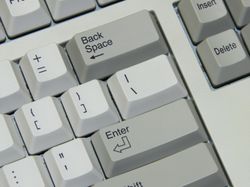Backspace key
This article is a stub. You can help Deskthority by expanding it.
| Names | Backspace, Back Space, Delete, Del, Backarrow |
|---|---|
| Symbol |
← |
| ISO/IEC symbol |
⌫ |
| ASCII | 0x08 <BS> |
| USB | Keyboard DELETE (Backspace) |
Contents
Usage
In modern programs, the Backspace key deletes the character to the left of the cursor and move the cursor to that position.
Some older programs only moved the cursor, especially in overwrite mode. Originally, on typewriters, the Backspace key only moved to the previous character - you had to erase it using corrective tape or fluid. On some typewriters with erasing-tape there were separate Backspace and Delete keys.
The key was called Delete on many 8-bit machines and still is on Apple Macintosh. Different regional Macintosh keyboards have different legends: either "delete" or one of the two arrow symbols. DEC labelled it with the ISO symbol and called it the "Backarrow key".
Layout
Like most keys, the size of Backspace varies widely. The most common two sizes in modern keyboards are 1 unit and 2 unit. Modern ANSI and ISO keyboards typically use a 2 unit Backspace. Japanese keyboards widely use a 1 unit Backspace.
Older mechanical keyboards made in East Asia tended to have a "Big-ass" Enter key and a 1 unit Backspace, for example the well-known Chicony KB-5181/5182. The small Backspace key makes room for one of the keys displaced by the size of the Enter key. The combination of big-ass enter and 2 unit Backspace exists, for example the Tulip ATK 030244 and Monterey K104; in such cases, the displaced keys tend to be moved between the Control and Alt keys.
Some vintage keyboards that have the Enter/Return key further to the right than the norm typically place the Backspace key at the same position as a 1 unit key but extend its size towards the right to 1.25 or 1.5 units. Examples from Japan of such non-standard sizes include the Sony NEWS NWP-411A and a Topre JDL keyboard. The Atari ST has a 1.5 unit backspace and 1 unit keys below it to the right of a Return that is not displaced further right than standard.
ISO return and 2u backspace
Erase-Eaze
Erase-Eaze™ is a feature found in several brands of keyboard including Lexmark, NMB and BTC where the space bar is split and one side of the space bar functions as backspace. In some cases (e.g. NMB) either side of the space bar can be configured as an extra Backspace key.[Citation needed] In the case of Lexmark and BTC keyboards, the left side of the split space bar is marked with the editorial symbol for deletion, being a loop in a diagonal line.
BTC 8120 with Erase-Eaze key
Erase-Eaze is a trademark of Keyboard Advancements, Inc. and is covered in US patent 5711624 filed in 1996. The US trademark (serial number 74368270, registration number 1827290) was filed on 1993-03-15.
The USB HID tables does include support for an "Erase-Eaze" key (as "Keyboard Alternate Erase") but no keyboard or operating system is known to use it.
See: Keyboards with Erase-Eaze
External links
- Wikipedia — Backspace




